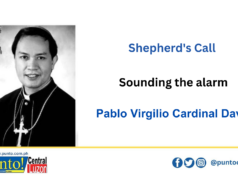TODAY’S READINGS are about the two pillars of the Christian faith, Paul in the first reading and Peter in the Gospel reading. But I wish to call attention not to these major characters on whom we have focused enough in the past few days. I wish instead to pay attention to the ones telling the story: Luke, in the Acts of the Apostles, and the evangelist, who wrote the fourth Gospel. Incidentally, both readings are the closing lines in the final chapters of both books: Chapter 28 for Acts, and Chapter 21 for John. Both authors are also putting their signatures on their compositions.
Talking of signatures, I remember seeing a beautiful bust of the Blessed Mother in the receiving room of the Collegio Filippino in Rome. I don’t know why I felt so drawn to this beautiful piece of sculpture. I remember saying to myself, “If this sculpture were done in wood, I know only of one artist who would have carved it, my kabalen from Betis in Pampanga, Willy Layug.”
Instead of just looking at the sculpture closely, since no one else was there, I decided to touch it, to let my hands feel the expression of the face of Mama Mary, her eyebrows that were tilted in anguish, her eyes that were half closed, some suggestion of tears flowing down her cheeks, her lips parted in an expression of agony. My hands went all the way to her neck and the base of the bust and I noted on the side what seemed like rough lines. I opened my eyes and said to myself, “This must be the artist’s signature.” I turned the sculpture to its side to allow the light from the window to cast a shadow on the inscription. There it was, the signature I was well-familiar with. It read “WILLY LAYUG, 2016, Carrara, Italy.” It was the signature that made me sure it was indeed done by my kabalen.
Signatures matter a lot in the world of art. They are a stamp of originality that affirm the value of the work. Imagine what it was like when, one day, we found a huge painting in the bodega of the CBCP. It was wrapped in newspaper and had been sitting there for years unnoticed. When we opened it, lo and behold, it was a painting of the scene of the baptism of the wife of Rajah Humabon who was renamed Juana. The painting had a signature on its lower righthand corner, which was later verified by a close relative of the artist. The signature was “Fernando Amorsolo.” The year he painted it was there too. Imagine how many millions of pesos it would be worth by now!
Today’s readings bear the signatures of their authors. The authors have signed their signatures, but you have to know where to find them. They did not do it the way modern authors or artists sign their signatures on their works. Perhaps, the late cartoonist Larry Alcala would come closer to their style. Larry Alcala put his face in side view profile in every one of his cartoon works, but you have to make an effort to find it.
In the first reading, which has the closing lines of the book of the Acts of the apostles, Chapter 28, Luke enters the scene again with his signature shift from THEY to WE. Not only does he shift from the third person to the first person plural to emphasize that he is present with Paul, he defines his role as an evangelist by connecting his life and mission with that of Paul. There, he says, “…with complete assurance and without hindrance he proclaimed the kingdom of God and taught about the Lord Jesus Christ.”
On the other hand, in the closing lines of the fourth Gospel, in John 21, the signature of the writer of the fourth Gospel is not his name but a title he gives himself, “The Disciple whom Jesus Loved.” I don’t think he was suggesting that Jesus did not love the other disciples. I think the writer just wants to insist that his identity no longer rests on himself or his own person but on the love of Jesus. It’s his way of saying “It is the love of Jesus that has made me who I am.”
You see, these great men did not mind disappearing, as long it was Jesus who appeared in them and through them. Here’s how the evangelist ends his work:
“It is this disciple who testifies to these things and has written them, and we know that his testimony is true.”
“There are also many other things that Jesus did, but if these were to be described individually, I do not think the whole world would contain the books that would be written.”
You know why not? Because Jesus has multiplied himself not just twelve times in his twelve apostles, but millions of times in the members of his body, the Church, all over the world. That includes you and me. To be a Christian is to continue to tell the story of Jesus through our own lives and our own stories.
(Homily for Saturday after Ascension – 7th Week of Easter – 30 May 2020, John 21:20-25)





